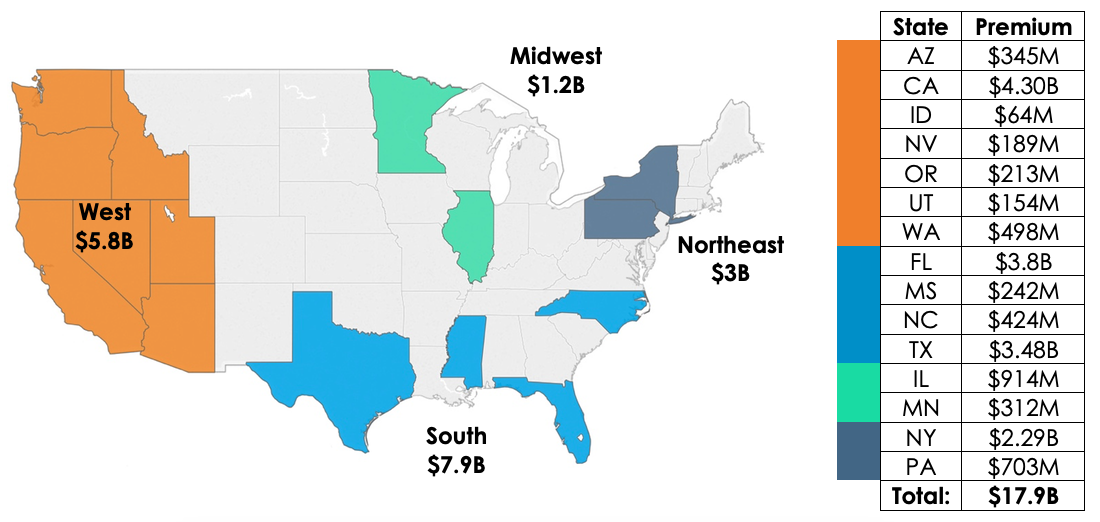US Surplus Lines Premium Up 12.7%
PRESS RELEASE

SLTX, Austin, TX – Mid-year premium growth reported by the 15 excess and surplus lines (E&S) stamping/service offices across the United States has reached almost $18 billion. Given the fact that the data reported is half way through 2019, the growth represents a 12.68% increase over what was recorded at mid-year 2018. The mid-year summary denotes that 14 of the 15 service office states all experienced premium increases, while 13 also recorded increases in policy filings.
The largest gains went to Minnesota, Arizona, North Carolina, California, and Idaho, who reported the highest premium increases, at 24.6%, 21.1%, 18.9%, 18.2%, and 15.7%, respectively.
While attributed to a number of reasons, Minnesota and California saw increases partially due to late policies (those filed in 2019 but effective in 2018), with California’s premium being impacted by several large-scale late policies with premiums of greater than $100 million. Adding to these differentials, Nicholas Schroeder, Executive Director, Surplus Lines Association of Minnesota stated, “I believe we are likely up about 10% in 2019 over mid-year 2018 if we remove the few large transactions with 2018 effective dates.” Furthermore, a benefit to the home state rule was felt by Idaho, wherein large property accounts previously recorded elsewhere are now being reported back to the state of Idaho. Undoubtably, a positive and obvious gain for Idaho.
On the other hand, Arizona’s 21% increase was attributed to overall increases by policy, with evident changes occurring in construction, professional, and general liability classes, according to Scott Wede, Executive Director, Surplus Line Association of Arizona.
Similarly, In North Carolina, several class codes had significant changes. “A noticeable amount of the North Carolina surplus lines premium growth is in the property coverage codes,” said Geoff Allen, Chief Operating Officer, North Carolina Surplus Lines Association, who went on to report, “This is primarily from rate increases and additional coverage being purchased as a result of the two hurricanes that hit North Carolina in 2018. The remainder of the premium increase this year is due to economic growth in North Carolina.”
Five (5) other states also reported double-digit premium increases: Mississippi (14.3%), Florida (14.2%), Texas (13.4%), Illinois (11.3%), and Oregon (11.1%).
Peggy Dronet, Executive Director, Mississippi Surplus Lines Association, said that a favorable economy contributed to her state’s premium growth. “The uptick in the economy has had a huge impact within our state,” Dronet said, “especially in the lower 5 coastal counties, where over half of the increase was generated.”
This too was the same experience for the Sunshine State, as Florida’s premium and filings increases reported favorable market conditions for the state and the surplus lines market in general. According to Sheila Pearson, Controller, Florida Surplus Lines Service Office, “We’re seeing a lot of coverages with double digit increases over last year, higher than the 14% increase in premium.”
Utah recorded the highest increase in filings with a 20.2% growth, followed by Washington at 17.6%. Other states with notable filing growth include Florida (8.71%), Arizona (8.53%), and Mississippi (7.36%).
The Surplus Lines Stamping of Texas conducts both the mid-year and end-of-year analysis, and per Norma Essary, Chief Executive Officer, the mid-year report included modest filing decreases that could easily be attributed to timing/filing differences for agents/brokers in the states of Illinois (0.22%) and Minnesota (1.09%), while Nevada experienced a slight premium decrease of 1.49%. Essary concluded, “The slight reductions are not significant enough to be of concern; however, overall, the mid-year report from our business partners and peers support a number of different factors, all of which include robust state economies, consumer driven need (buyers & risk managers), expanded capacity of the surplus lines market, and a major reason – rate increases.” In Texas, the 13.4% increase is predominately driven by the hardened market. Carriers are raising their rates across the board, with risk managers preparing their commercial entities for renewals with double-digit policy increases. Likewise, carriers are assessing the domestic/global large-scale events, political environments, M&A upheavals, and making it a priority to reassess risk, loss ratios, market disruptions, profitable coverage lines, and appropriately resetting business strategy and operations, after years of operating in a soft market.
